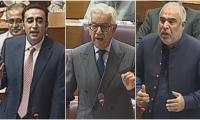ISLAMABAD: The government has inserted a special chapter titled “COVID-19 Advent and Impact Assessment” into the Economic Survey 2019-20 and assessed that unemployment and poverty will rise in the country.
It states that after recording its first contractionary year due to the COVID crisis since 1952, Pakistan is likely to face greater challenges in the next fiscal year starting July 2020.
“With an expected 2 percent growth for next year which is even lower than the population growth rate, challenges such as unemployment and poverty are expected to persist and amplify” it stated.
Socio-economic impact assessment: An estimated 56.6 percent of the population is socio-economically vulnerable due to the COVID-19 crisis. Women and children, especially those from more disadvantaged households and those who are home-based workers, will be among the most impacted. The Labour Force Survey 2017-18, estimates an employed labour force of about 61.7 million across Pakistan of which 23.8 million are agriculture workers and 37.9 million are non-agriculture workers. Out of 37.9 million non-agriculture workers, 27.3 million (72 percent) work in the informal sector. It is these 27.3 million informal sector workers that are most at risk of losing their livelihoods as a result of the COVID-19 crisis.
The top two sectors where these informal economy workers are employed are wholesale and retail trade (33 percent) and manufacturing (23 percent).
Among the most vulnerable, the expected loss of employment (across both the agriculture and non-agriculture sectors) is estimated to be between 12.5 million to 15.5 million in case of moderate slow-down of economic activity/partial lockdown, and between 18.7 million and 19.1 million in case of severe restrictions to economic activity/full lockdown. It is expected that wholesale and retail trade will lose maximum workers followed by manufacturing, construction and transport.
Enterprise and entrepreneurship: According to Smeda, 3.25 million SMEs constitute nearly 90 percent of all enterprises in Pakistan and contribute approximately COVID-19 Advent and Impact Assessment 327 40 percent to annual GDP. Since most of SMEs are not documented (other than those workers registered under EOBI or a social security programme), they are not protected against loss of employment.
Labour migration and overseas Pakistanis: Due to the resultant contraction in the global economy and restrictions on international and intercity travel, migrant workers (overseas Pakistanis) may be adversely impacted in terms of permanent or temporary unemployment, or reduction in incomes. About 50,000-60,000 migrant workers who completed their registration at the Protectorate Office could not proceed overseas due to travel restrictions and domestic and international lockdown. Additionally, hiring for 100,000 foreign positions has been halted. Inequalities in labour force: Women dominate professions such as domestic workers, teachers and instructors in schools and colleges; several are also employed by SMEs.
Holding the pandemic as mainly responsible for disrupting transition of achieving stabilization, the Economic Survey conceded that the government missed out all major macroeconomic targets by huge margins including shrinking GDP growth, higher inflation, rising fiscal deficit, lower investments to GDP ratio, stagnant exports and declining remittances.
Launching the Economic Survey for 2019-20, Advisor to the Prime Minister on Finance Dr Abdul Hafeez Shaikh said the outbreak of coronavirus caused heavy losses to the national economy and GDP size shrank by over Rs3 trillion in outgoing fiscal year.
He specially thanked Chief of Army Staff General Qamar Javed Bajwa for freezing the defense budget.
The survey shows that the per capita income in US dollar nosedived to $1355 in outgoing fiscal year 2019-20 against revised estimates of $1455, indicating that the per capita income dropped by $100 for every Pakistani.
The per capita income stood at $1651 in 2017-18 in last five- year term of PML (N) and it decreased to $1355 in 2019-20, showing that per capita income decreased by $296 for every Pakistani in last two years under dispensation of PTI led government.
The inflation had peaked to 14.6 percent in January 2020 but in post COVID-19, it started receding and now stood at 8.4 percent on average in July-April period of current fiscal.
However, the government took stance that the Current Account Deficit (CAD) improved, non-tax revenue surpassed the target and PTI led government doubled funding for Ehsaas programme to the tune of Rs 192 billion for outgoing fiscal year.
“The PTI government inherited macroeconomic instability as the current account deficit stood at $20 billion, exports growth was flat, foreign exchange reserves were $9 billion, flawed exchange policy resulted into cheap imports and the country was heading towards default” Dr Abdul Hafeez Shaikh said, adding that the public debt and liabilities stood at Rs30 trillion.
He said that the incumbent government sought help from bilateral donors and finally got package of $6 billion to stabilize the economy.
Debt servicing, he said, consumed Rs5,000 billion to pay back outstanding debt liabilities. He said that there were different components of rising debt burden as the PTI led government increased debt burden by Rs 10.5 trillion but it took only Rs 1.5 trillion for increased expenditures and remaining increase was occurred because of depreciation of rupee against dollar. He said that the government did not get penny as borrowing from State Bank of Pakistan.
On GDP growth rate, he said that the existing estimates suggest that the GDP growth contracted to negative 0.38 percent for outgoing fiscal year against pre-COVID-19 estimates of growth in the range of 2.5 percent. The agriculture sector grew by positive 2.67 percent, industries negative 2.64 percent, services negative 3.4 percent and transport & communication -7.1 percent for outgoing fiscal year. The manufacturing sector, he said, nosedived by negative 22 percent.
Asked about revision in GDP growth to 1.9 percent for last fiscal year 2018-19 from provisional estimates of 3.3 percent, he said “I agree with you that such massive adjustment is not happened” but it also highlighted the requirement for undertaking institutional strengthening and bringing improvement in data collection. He also hinted about the requirement of GDP rebasing to calculate the growth figures. He said that the government believed in transparency and honesty and did not want to hide anything.
The Economic Survey states that similar to the entire world, Pakistan’s economy has also been affected due to COVID-19 outbreak through various channels like decline in domestic as well as global demand, down turn in tourism and business travel, trade and production linkages and supply disruptions etc.
The rapid spread of the COVID-19 virus since February 2020 has brought economic activity to a near-halt. However, magnitude of economic losses will depend on intensity and duration of COVID-19.
The provisional GDP growth rate for FY2020 is estimated at negative 0.38 percent on the basis of 2.67, -2.64 and -0.59 percent growth in agricultural, industrial and services sectors respectively.
Thus, the negative impact of COVID-19 was so pronounced that the services sector posted negative growth of 0.59 percent.
The outlook therefore carries challenges due to uncertainties associated with it. The macroeconomic stabilization measures undertaken by the government over the past year resulted in significant reduction in Saving-Investment Gap, which was mainly driven by reduction in trade deficit and increase in workers’ remittances.
It is also mentionable that fiscal deficit remained contained in first three quarters of FY2020 at 4 percent of GDP and primary deficit turned into surplus, said Hafeez.
Historically, private consumption had significantly contributed in Pakistan’s economic growth. The pattern was likely to continue, however, due to COVID-19, private consumption suffered significantly.
In percentage of GDP, it dropped to 78.5 percent in FY2020 compared to 82.9 percent in FY2019. Private Investment as a percentage of GDP dropped to 9.98 percent from 10.29 percent in FY2019 while Public Investment (including General Government investment) has shown improvement as it remained 3.8 percent compared to 3.7 percent last year.
However, there was 13.2 percent growth in Public Investment (including General Government investment) during FY2020, while it declined by 21.6 percent last year.
The crops sector has witnessed positive growth of 2.98 percent during FY2020 mainly due to positive growth of 2.90 percent in important crops.
According to Pakistan Bureau of Statistics, fourth quarter has been estimated by keeping in view the lockdown situation faced by the industrial sector due to COVID-19. Significant impact has been observed in the manufacturing sector, particularly Large-Scale manufacturing and Small-Scale Manufacturing.
The provisional growth in industrial sector has been estimated at -2.64 percent mainly due to a negative growth of 8.82 percent in mining and quarrying sector and decline of 7.78 percent in large-scale manufacturing sector. Due to lock down situation in the country, the growth estimates of Small-Scale Industry for FY2020 are 1.52 percent. Similar to the industrial sector, services sector of the economy has also witnessed significant impact of the lock down situation in the country due to COVID-19, particularly in Wholesale and Retail Trade and Transport Sectors. The services sector has declined provisionally at 0.59 percent mainly due to 3.42 percent decline in Wholesale and Retail Trade sector and 7.13 percent decline in Transport, Storage and Communication sectors. Finance and insurance sector witnessed a slight increase of 0.79 percent. The Housing Services, General Government Services and Other private services have contributed positively at 4.02, 3.92 and 5.39 percent respectively.
The agriculture sector recorded strong growth of 2.67 percent, considerably higher than 0.58 percent growth achieved in last year.
Livestock Sector achieved the growth of 2.58 percent. The Fishing sector grew by 0.60 percent, while Forestry sector increased by 2.29 percent.
Manufacturing and Mining, the Large-Scale Manufacturing (LSM) declined by 5.4 percent during July-March FY2020 Pakistan Economic Survey 2019-20 vi as compared to 2.34 percent decline during the same period last year. There are number of factors, which contributed to negative growth of LSM. Pak rupee depreciated by 3.9 percent during July-March FY2020 which increased the cost structure of industries in general and for those relying on imported raw materials in particular.
Automobile sector alone accounted for major portion of contraction in LSM. Its prices witnessed multiple upward revisions due to PKR depreciation, which held the potential buyers from making booking and purchases. Upward adjustment in electricity prices dented domestic steel producers’ margins. The Mining and Quarrying sector showed negative growth of 8.82 percent during FY2020 as against 3.19 percent decline last year.
Meanwhile, the cost of tax concession enjoyed by powerful lobbies/influential sectors has further ballooned and is going to cost the national exchequer to the tune of Rs 1.149 trillion in outgoing fiscal year 2019-20 against Rs 0.972 trillion in last financial year 2018-19.
The survey showed that the cost of tax exemption increased by Rs177 .5 billion in the ongoing financial year.
The single largest surge in tax exemption cost has come from sales tax on imports, showing massive revenue loss of Rs 255.843 billion during 2019-20, followed by Rs 212.070 billion from exemption from total income during 2019-20.
The cost of sales tax exemptions amounted to Rs518.814 billion in 2019-20 against Rs597.7 billion in 2018-19; income tax, Rs378.03 billion against Rs141.6 billion; and cost of customs duty exemptions was Rs253.111 billion in 2019-20 against Rs233.1 billion in 2018-19.
Despite withdrawal of sales tax zero-rating facility from five leading export-oriented sectors - textile, leather, carpets, surgical and sports goods from 2019-20, the cost of sales tax exemption still remained higher at Rs518.814 billion in 2019-20.
The cost of income tax exemption has been increased by Rs 236.426 billion in 2019-20 when compared with previous year. The Economic Survey has not mentioned revenue loss on account of exempt business income granted to independent power producers (IPPs).
The accumulative revenue loss on account of tax credits amounted to Rs104.498 billion. This year the government has not specified details of revenue loss on account of tax credits for charitable donations, tax credit under section 100C and revenue loss on account of tax credit for investment in shares and insurance under section 62 of the Income Tax Ordinance.
The survey has also not mentioned revenue loss on account of sales tax exemptions available under the Sixth Schedule (Exemption Schedule) of the Sales Tax Act. In 2018-19, FBR has suffered massive revenue loss of Rs 301 billion in 2019-20 due to sales tax exemptions available under the Sixth Schedule (Exemption Schedule) of the Sales Tax Act.
The FBR has suffered a loss of Rs118.137 billion due to sales tax exemptions available under the Eight Schedule (Conditional Exemption) of the Sales Tax Act, 1990 during the period of 2019-20 against Rs156 billion.
The revenue loss from conditional exemptions has been reduced by Rs 37.863 billion. Other reduced rates of sales tax have caused revenue loss of Rs53.138 billion during 2019-20.
The exemption of sales tax on cellular mobile phones under Ninth Schedule of the Sales Tax Act 1990 resulted in revenue loss of Rs 23.154 billion during 2019-20.
On the other hand, the revenue loss on account of rationalization of corporate tax rate in 2019-20 has not been mentioned in the survey.
In 2017-18, the rationalization of corporate tax rate caused huge revenue loss of Rs 12 billion during this period.
The total revenue loss from zero-rating facility granted to different sectors under Fifth Schedule of the Sales Tax Act 1990 amounted to Rs13.671 billion during the period under review against Rs54.09 billion in 2018-19, reflecting a negative growth of Rs40.419 billion.
Deceased, identified as Hasnain, had been serving Justice Jawad Hassan for 25 years
On Wednesday evening, Riaz called on prime minister alongside Pakistan Sports Board officials
Hussain Mohammed emphasised government’s commitment to facilitating business partnerships and promoting economic...
Former minister Imtiaz Safdar also met Bilawal at Zardari House, where they discussed political situation in Punjab
Meeting was held by Finance Secretary on December 1, 2023 over issue but it remained indecisive
Formal sector, which contributes over 98% of tax revenue collected from industry, is shrinking







